 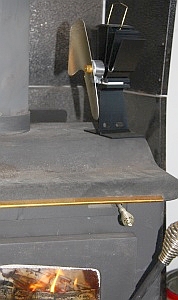
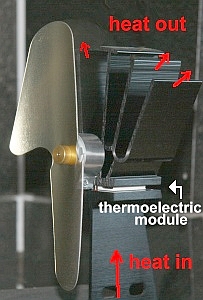 A common addition to a wood stove heater is a fan which sits on the stove and spins all by itself, without a battery or electrical plug-in. How it works involves an explanation of the thermoelectric effect and semiconductors.
A common addition to a wood stove heater is a fan which sits on the stove and spins all by itself, without a battery or electrical plug-in. How it works involves an explanation of the thermoelectric effect and semiconductors.
The fan generates its own electricity due to the difference in temperature between the top of the stove and the top of the fan. The base of the fan sits on the hot stove, at a temperature of 65°C or hotter; meanwhile, the top of the fan is much cooler due to the cooling fins, which radiate away heat. When the thermoelectric module in the fan experiences this heat differential, it generates electricity, which causes a small motor to turn the fan. In order to understand the conversion of a heat difference into electricity, we'll look at the thermoelectric module in more detail, and discover how a semiconductor works. A semiconductor is a crystalline metal with impurities added to it. (This is called 'doping'). These impurities can either add free electrons to the substance, or add 'holes' where electrons can be accepted. For example, silicon crystal doped with boron creates an n-type semiconductor with extra electrons; doping it with phosphorus atoms results in a p-type semiconductor that accepts electrons. 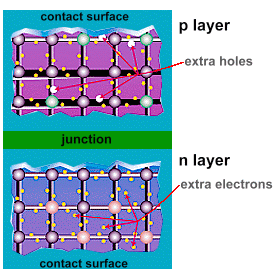
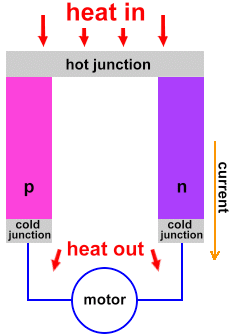 The weakly-bound electrons introduced in the n-type material can move about in the crystal lattice freely, and will cause a current to flow in the presence of an electric field, or voltage.
The weakly-bound electrons introduced in the n-type material can move about in the crystal lattice freely, and will cause a current to flow in the presence of an electric field, or voltage.When a temperature difference exists between the two semiconductors, a continuous current is formed in the conductors if they form a complete loop. The heat source drives electrons in the n-type element toward the cooler region, creating a current. Holes in the p-type element will 'flow' in the direction of the current. This current is what powers the motor. 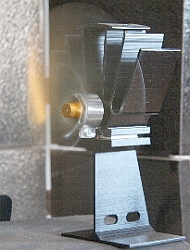
Summary: When two different semiconductors (n-type and p-type) at the same temperature are connected together they establish an electric potential difference, or voltage. When a temperature difference is applied, heat flows across the joined semiconductors; this causes electrons to flow. The resulting current powers the fan's motor. |